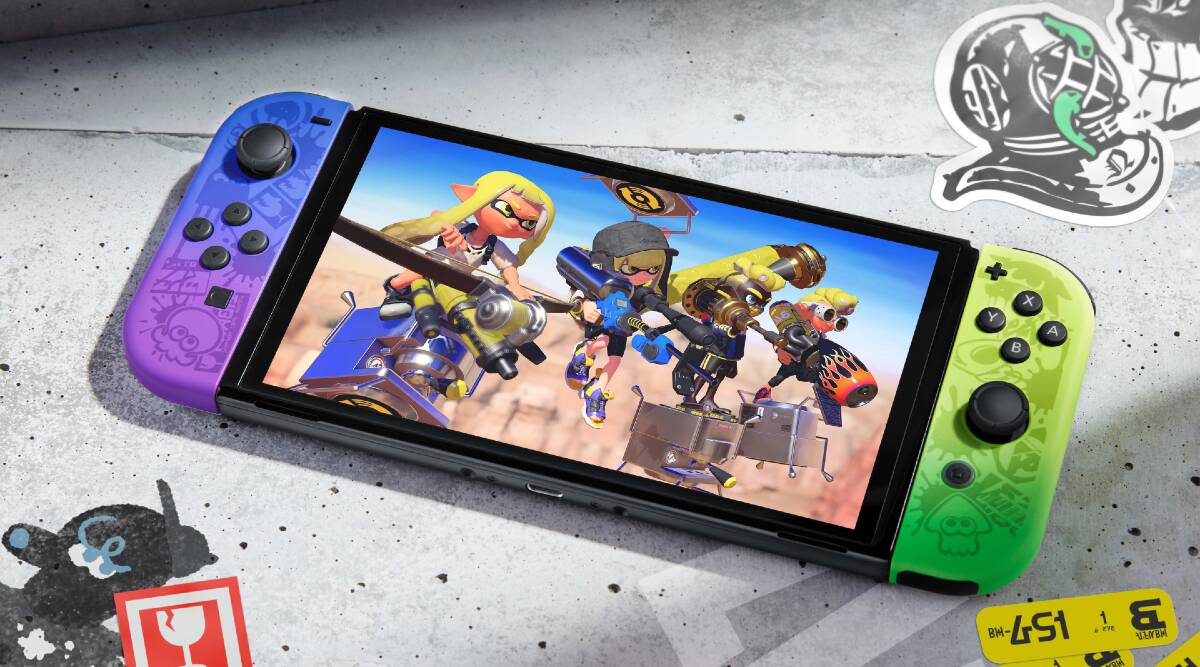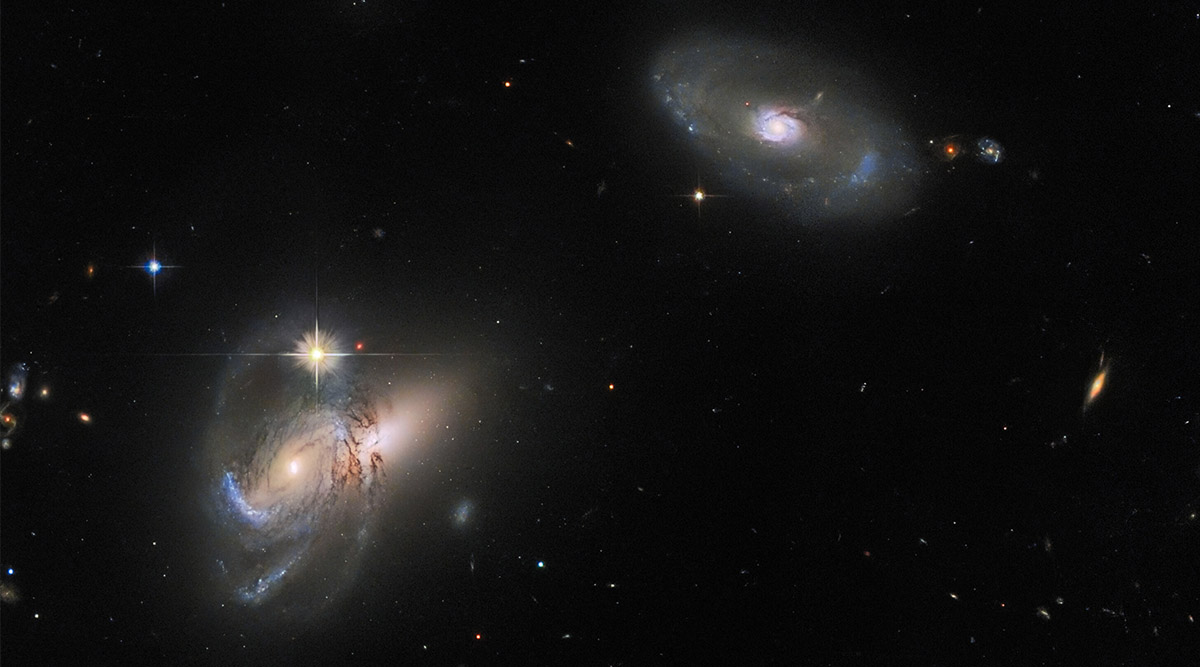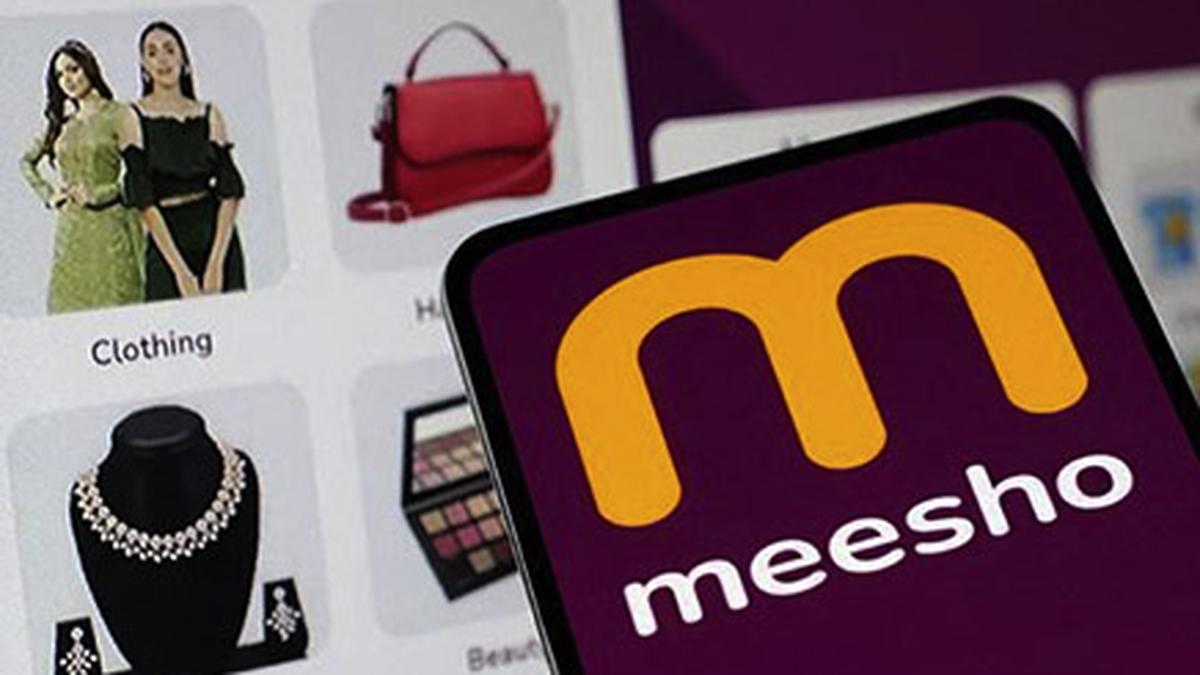When Android 12 was announced back in 2021, its ‘Material You’ design was the key highlight. With the ability to customise Homescreen and Lockscreen, last year’s update marked one of the biggest design changes to Android’s user interface. So now that Android 13 is officially here, the question on my mind was: What’s new here? The announcement does feel a bit underwhelming and seems to be more of an incremental update. Frankly, after I had installed Android 13 on the Pixel 6a, I was struggling to discover what had changed compared to Android 12. But there are changes — some geared towards better productivity, and it seems Google is focusing more on big screens and connectivity between devices. After having used Android 13 for the past three days, here are my quick thoughts on this latest update.
Android 13: Installing it on the Google Pixel 6a
Installing Android 13 on the Google Pixel 6a was anything but straightforward. At first, I thought the update might take a day or so to appear, given rollouts are often done in phases by companies. But when I didn’t see the update on the phone for two days, I was confused. The whole point of Pixel phones is that they are the first ones to get the latest version of Android.
So I decided to install the device into the ‘beta’ program. And that’s how I got the stable version of Android 13 on my phone. I’m not the only one who has taken a similar roundabout approach going by the experiences being shared on Twitter. However, it looks like the regular stable update has also arrived on most phones and it should on your Pixel 6a or other Pixel device. I did opt out of the beta to check if the version of Android 13 I had would get removed, but that has not happened.
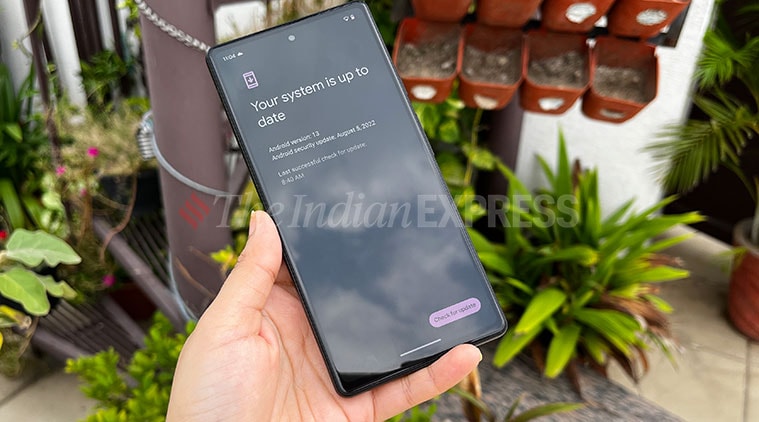 Android 13 on the Pixel 6a. The update should be available on your device from today. (Image credit: Shruti Dhapola/Indian Express)
Android 13 on the Pixel 6a. The update should be available on your device from today. (Image credit: Shruti Dhapola/Indian Express)
The update was around 2GB in size when I saw the file appear on my phone. Make sure you have enough space on your Pixel device and that you are connected to WiFi when installing.
Android 13: Some more of ‘Material You’
As I have already noted, the design changes are not as apparent, especially when you first install the update. But Android 13 does mark a subtle expansion of the ‘Material You’ theme to more apps beyond the usual Google-owned ones. While Themed Icons was introduced in Android 12, it is now being extended to third-party apps as well. So if you have the customisation feature turned on for your Homescreen and Lockscreen, you should now see other apps also following the same colour theme on the Homescreen.
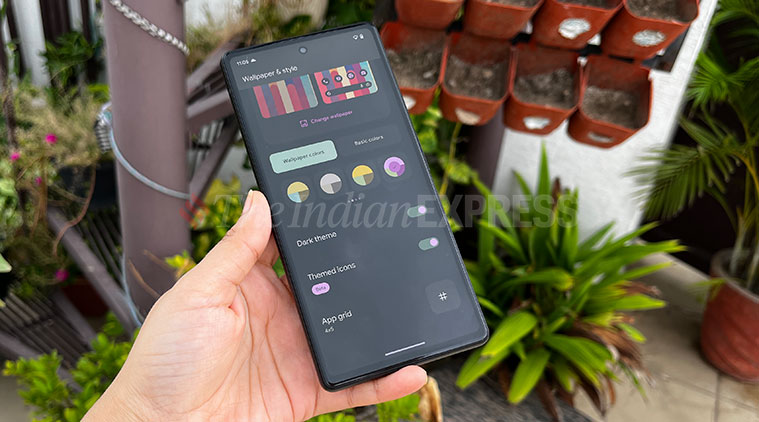
 Android 13 allows third-party apps to join the colour theme of the Material You design. But developers need to support this as well. (Image credit: Shruti Dhapola/Indian Express)
Android 13 allows third-party apps to join the colour theme of the Material You design. But developers need to support this as well. (Image credit: Shruti Dhapola/Indian Express)
You will have to turn on Themed Icons in the Wallpaper settings and it is still in beta. Hopefully, with more developers adopting this, it will allow for more uniformity on the Homescreen. But, this is limited in the sense that the app developer needs to activate it. For instance, I noticed that while the WhatsApp icon was in sync with the theme, Facebook and Instagram’s icons have not followed suit. It still feels a bit incomplete.
Android 13: Good-bye notifications from every single app
This is perhaps the most understated and most useful feature on Android 13. Now, after you install each app it will ask whether notifications should be allowed in the first place. If you find that your notifications tray is full of alerts from random apps, this change should at least ensure some peace of mind.
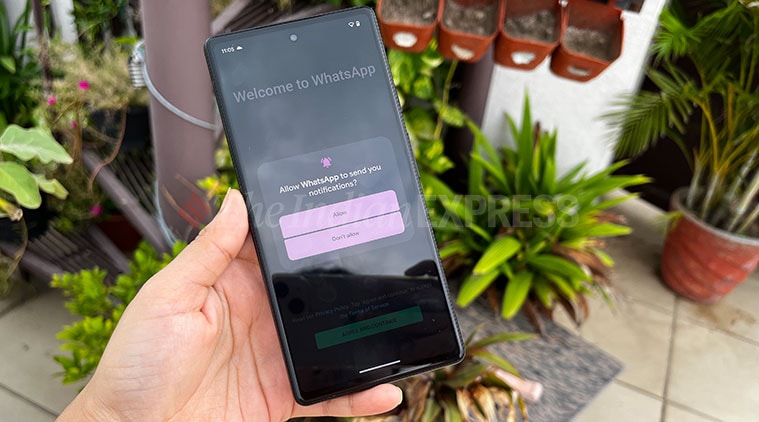
 You can now ensure that only approved apps give notifications. (Image credit: Shruti Dhapola/Indian Express)
You can now ensure that only approved apps give notifications. (Image credit: Shruti Dhapola/Indian Express)
A user can decide straight up to block notifications from an app soon after downloading, instead of going into settings, etc. I don’t need to see every single notification from Facebook or Instagram or Zomato or any game I’ve just installed. For someone like myself, who has access to at least five phone screens daily, this is particularly useful. It ensures I have at least one less screen to distract me.
Android 13: The clipboard is neater, privacy tweaks
Android 13 is also updating the clipboard for better privacy and the interface is also neater. Now when you copy-paste any text, it appears as a floating window at the bottom with a little share notification next to it. I quite liked this approach. At least I can see what I just copied. Sometimes I find that the touchscreen-based copy-paste leads to a few numbers or letters being missed.
Google is also adding more privacy to the clipboard and will protect sensitive data on the clipboard such as bank accounts, passwords, etc. The clipboard data will also get erased automatically after some time. I could not find a setting that confirms this.
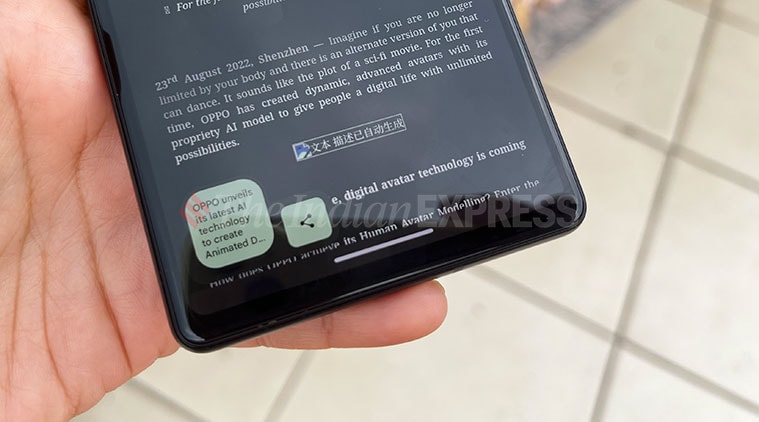
 The clipboard on Android 13 has been given a design tweak (Image credit: Shruti Dhapola/Indian Express)
The clipboard on Android 13 has been given a design tweak (Image credit: Shruti Dhapola/Indian Express)
But in the Settings app, you can also toggle on an option to see when an app accesses text, images or other content you’ve copied. Apple’s iOS already does something familiar, so it looks like Google is playing catch up.
Android 13 is improving privacy further when it comes to your photo library. It will let you share only selected photos with an app, instead of the entire library. Again, these restrictions are already present on iOS.
Android 13: More languages settings for your apps
You can now custom set a different language for third-party apps. For instance, if you prefer using Facebook in your mother tongue, say Hindi or Malayalam or Tamil, you should ideally have that option. So while your entire device’s system language might remain English, you could choose a different language for each app.
The only problem right now is that apps need to support this as well. The app where I could see an option to change the language setting was Google News.
Android 13: QR code scanner
This one will appeal to all of us in India given how often we need to scan payment QR codes. You can now directly access the QR code scanner as a tile in the Quick Settings Menu at the top. I just swiped down on the Menu and tapped on Edit and I could see the option to add a QR code scanner as a dedicated title.
Further, Google will allow more third-party apps which support these tiles to be added to Quick Settings. I’m yet to see too many apps which have this option turned on. But it would be cool if apps like WhatsApp supported this.

 Android 13’s QR code scanner seen in the Quick Settings menu. (Image credit: Shruti Dhapola/Indian Express)
Android 13’s QR code scanner seen in the Quick Settings menu. (Image credit: Shruti Dhapola/Indian Express)
Android 13: The other big stuff I can’t access
Android 13 isn’t just about adding new features to phones. It is also about bringing more features to tablets and making the software better optimised for bigger screens and other form factors. There’s better productivity, multitasking on tablets, a new taskbar, better split-screen view, to name some features. There’s also better continuity between Android phones and Chrome– for instance the ability to send and receive messages from the laptop on the phone. Or the ability to copy any content from the phone and paste it onto the tablet. Sadly I can’t access or try any of this because a) I don’t have a Chromebook and b) I doubt any tablet has got Android 13 yet.
Android 13: So how much are you missing out…
At the moment, if your phone is still on Android 12, you are not missing out on much. And of course, developers also need to adopt some of the features that Android 13 is introducing. Yes, the Android 13 update doesn’t have the pomp and flair that one typically expects in new software.
But it comes with some subtle features and changes, which I think make it a lot more productive and useful. The notifications aspect is particularly welcome since it can cut down distractions for many of us. The improved clipboard and better privacy for the photo library are also good. Google is adding Spatial Audio support and Bluetooth LE as well. The former will require headphones that support this.
What I am keen to test out is how Android 13 improves tablets, considering these are having a serious revival moment in the Indian market with several brands launching many affordable and mid-range tablets. Most of these are on Android 12 and we don’t know how soon Android 13 will come to these tablets. And that remains Android’s biggest problem.
We don’t know when most phones will get the update, including the slightly mid-premium ones. That’s because testing and fine-tuning along with chipset support take time for most manufacturers. Some like OnePlus, Oppo, Realme, Samsung and Vivo have announced their Android 13 timeline. But the process ends up taking a few months at the very least. So yes, if you have a non-Pixel device, then your wait for experiencing this latest version of Android could be a long one.
!function(f,b,e,v,n,t,s)
{if(f.fbq)return;n=f.fbq=function(){n.callMethod?
n.callMethod.apply(n,arguments):n.queue.push(arguments)};
if(!f._fbq)f._fbq=n;n.push=n;n.loaded=!0;n.version=’2.0′;
n.queue=[];t=b.createElement(e);t.async=!0;
t.src=v;s=b.getElementsByTagName(e)[0];
s.parentNode.insertBefore(t,s)}(window, document,’script’,
‘https://connect.facebook.net/en_US/fbevents.js’);
fbq(‘init’, ‘444470064056909’);
fbq(‘track’, ‘PageView’);




